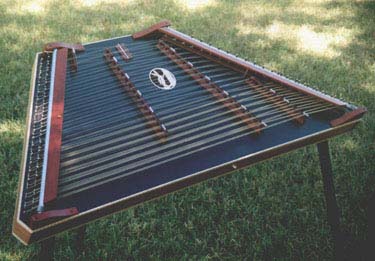 The hammered dulcimer is a musical instrument consisting of a trapezoid wooden box with strings stretched over bridges sitting atop the soundboard. It's played by hitting the strings with small wooden hammers. The sound is enchanting, and seems to be the main reason folks learn to play.
The hammered dulcimer is a musical instrument consisting of a trapezoid wooden box with strings stretched over bridges sitting atop the soundboard. It's played by hitting the strings with small wooden hammers. The sound is enchanting, and seems to be the main reason folks learn to play.There's some debate about the hammered dulcimer's background, but it's believed by many to have originated in ancient Persia some 2,000 years ago. Variations can be found all over the world, but the instrument as we know it in America developed primarly in the British Isles.
The hammered dulcimer is a very accessible instrument, which is to say that it's fairly easy for the beginner to get a good tone. And because it's constructed around major scales, it's pretty easy to find simple tunes. In fact, most folks learn by following patterns, even if they can read music. Of course, playing well takes dedication and practice, but the rewards are well worth it.
The only drawback is that hammered dulcimers are a little hard to find, because they're not "mainstream" instruments made in the tens of thousands. On the plus side, nearly all hammered dulcimers are hand-crafted by skilled artisans, so you're likely to get a quality instrument no matter who you buy from or what model you buy. Prices start around $250 for a small student model and go as high as $3,000 for larger, more complex models.
How It Works
Hammered dulcimers are strung side to side, with the strings crossing over the treble bridge (to the left) or the bass bridge (to the right). Notes are played by hitting the strings near the bridges with small wooden hammers. Most dulcimers have at least two strings for each note, mainly for volume, and each string pair is called a "course."If you've ever looked inside a piano, you probably noticed that the hammered dulcimer works on the same principle, which is wooden hammers hitting tuned strings. This is natural, since the hammered dulcimer is one of the piano's ancestors. The obvious difference is that the piano has a separate, fixed hammer for each course, while the hammered dulcimer has only two hammers, which the player moves to hit different strings.
But that's not all. For one thing, the dulcimer isn't laid out in a straight line like a piano. Instead, it's structured around major scales, with half of the scale on each side of a "box" pattern, like this (the vertical line represents the treble bridge):
| 8 D --*-- G 4 7 C# --|-- F# 3 6 B --|-- E 2 5 A --*-- D 1 |
Notice, too, that there are no extra sharps or flats along the way -- just the notes you need for the D major scale. This is called a "diatonic" pattern, and it's repeated for other scales up and down the instrument, with bridge markers (indicated by asterisks in the diagram) to show where each half-scale starts and ends:
treble bass C --*-- F Bb --* B --|-- E A --| A --|-- D G --| G --*-- C F --* F# --|-- B E --| E --|-- A D --| D --*-- G C --* C# --|-- F# B --| B --|-- E A --| A --*-- D G --*
Dulcimers come in a variety of sizes, classified by the number of courses on the treble and bass bridges, respectively, as 12/11, 15/14, etc. The 12/11 is the basic size, with a range of 2-1/2 octaves, starting from G below Middle C. The 15/14 is probably the most common size, adding a half-octave to the lower end of the 12/11, down to D below Middle C, for a full three octaves. There are many variations on this theme, some smaller, most larger, and many with some sharps and flats not found on a standard diatonic dulcimer.
But the best way to hear the hammered dulcimer is in its "home court." Many fine records are available, and I encourage you to listen if you have any interest. Some of the better-known folks are listed below, and if you go to any of the bigger folk festivals, you may be lucky enough to catch one or more of them in performance or teaching a workshop. (I apologize in advance if I've missed anyone or misspelled any names, and will make updates as needed.)
If you know how to play and just want to jam, I'd like to hear from you, too.